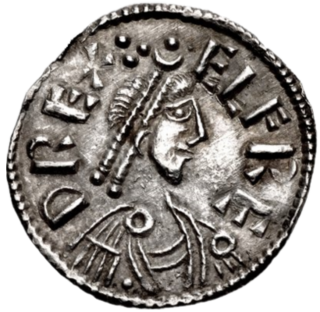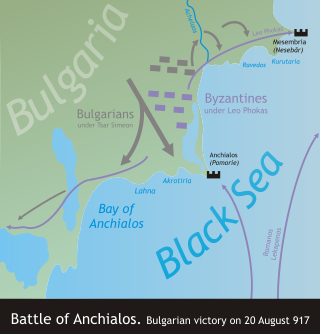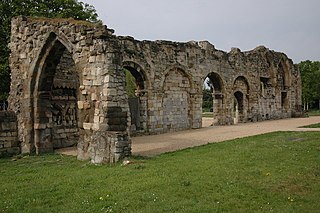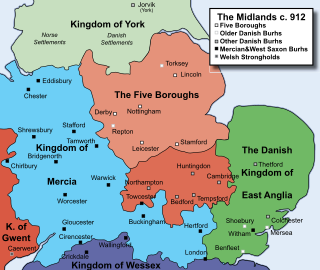
Alfred the Great was King of the West Saxons from 871 to 886, and King of the Anglo-Saxons from 886 until his death in 899. He was the youngest son of King Æthelwulf and his first wife Osburh, who both died when Alfred was young. Three of Alfred's brothers, Æthelbald, Æthelberht and Æthelred, reigned in turn before him. Under Alfred's rule, considerable administrative and military reforms were introduced, prompting lasting change in England.

Mercia was one of the three main Anglic kingdoms founded after Sub-Roman Britain was settled by Anglo-Saxons in an era called the Heptarchy. It was centred on the River Trent and its tributaries, in a region now known as the Midlands of England.

Æthelflæd ruled as Lady of the Mercians in the English Midlands from 911 until her death in 918. She was the eldest child of Alfred the Great, king of the Anglo-Saxon kingdom of Wessex, and his wife Ealhswith.

Year 917 (CMXVII) was a common year starting on Wednesday of the Julian calendar.

The Danelaw was the part of England between the early tenth century and the Norman Conquest under Anglo-Saxon rule in which Danish laws applied. The Danelaw originated in the conquest and occupation of large parts of eastern and northern England by Danish Vikings in the late ninth century. The term applies to the areas in which English kings allowed the Danes to keep their own laws following the tenth-century English conquest in return for the Danish settlers' loyalty to the English crown. "Danelaw" is first recorded in the early 11th century as Dena lage.
A fyrd was a type of early Anglo-Saxon army that was mobilised from freemen or paid men to defend their Shire's lords estate, or from selected representatives to join a royal expedition. Service in the fyrd was usually of short duration and participants were expected to provide their own arms and provisions.
Repton is a village and civil parish in the South Derbyshire district of Derbyshire, England, located on the edge of the River Trent floodplain, about 5 miles (8 km) north of Swadlincote. The population taken at the 2001 census was 2,707, increasing to 2,867 at the 2011 census. Repton is close to the county boundary with neighbouring Staffordshire and about 5 miles (8 km) northeast of Burton upon Trent.

Æthelred became Lord of the Mercians in England shortly after the death or disappearance of Mercia's last king, Ceolwulf II, in 879. He is also sometimes called the Ealdorman of Mercia. Æthelred's rule was confined to the western half, as eastern Mercia was then part of the Viking-ruled Danelaw. His ancestry is unknown. He was probably the leader of an unsuccessful Mercian invasion of Wales in 881, and soon afterwards he acknowledged the lordship of King Alfred the Great of Wessex. This alliance was cemented by the marriage of Æthelred to Alfred's daughter Æthelflæd.

The Five Boroughs or The Five Boroughs of the Danelaw were the five main towns of Danish Mercia under the Danelaw. These were Derby, Leicester, Lincoln, Nottingham and Stamford. The first four later became county towns.

A burh or burg was an Anglo-Saxon fortification or fortified settlement. In the 9th century, raids and invasions by Vikings prompted Alfred the Great to develop a network of burhs and roads to use against such attackers. Some were new constructions; others were situated at the site of Iron Age hillforts or Roman forts and employed materials from the original fortifications. As at Lundenburh, many were also situated on rivers: this facilitated internal lines of supply while aiming to restrict access to the interior of the kingdom for attackers in shallow-draught vessels such as longships.

The Great Heathen Army, also known as the Viking Great Army, was a coalition of Scandinavian warriors who invaded England in 865 AD. Since the late 8th century, the Vikings had been engaging in raids on centres of wealth, such as monasteries. The Great Heathen Army was much larger and aimed to conquer and occupy the four kingdoms of East Anglia, Northumbria, Mercia and Wessex.

Hastein was a Viking chieftain of the late 9th century who made several raiding voyages.

The Burghal Hidage is an Anglo-Saxon document providing a list of over thirty fortified places (burhs), the majority being in the ancient Kingdom of Wessex, and the taxes assigned for their maintenance. The document, so named by Frederic William Maitland in 1897, survives in two versions of medieval and early modern date. Version A, Cotton Otho B.xi was badly damaged in a fire at Ashburnham House in 1731 but the body of the text survives in a transcript made by the antiquary Laurence Nowell in 1562. Version B survives as a composite part of seven further manuscripts, usually given the title De numero hydarum Anglie in Britannia. There are several discrepancies in the lists recorded in the two versions of the document: Version A includes references to Burpham, Wareham and Bridport but omits Shaftesbury and Barnstaple which are listed in Version B. Version B also names Worcester and Warwick in an appended list.

Edward the Elder was King of the Anglo-Saxons from 899 until his death in 924. He was the elder son of Alfred the Great and his wife Ealhswith. When Edward succeeded to the throne, he had to defeat a challenge from his cousin Æthelwold, who had a strong claim to the throne as the son of Alfred's elder brother and predecessor, Æthelred I.
Events from the 10th century in the Kingdom of England.

The Kingdom of the East Angles, informally known as the Kingdom of East Anglia, was a small independent kingdom of the Angles during the Anglo-Saxon period comprising what are now the English counties of Norfolk and Suffolk and perhaps the eastern part of the Fens, the area still known as East Anglia.
Sigeferth was, along with his brother Morcar, described by the Anglo-Saxon Chronicle as "chief thegn of the Seven Burghs".
Uhtred was an ealdorman based in Derbyshire in the 10th century. His date of birth and origins are unclear, although it has been suggested by some modern historians that he came from Northumbria. He is thought to have been the thegn who, having purchased land at Hope and Ashford in Derbyshire from the Vikings before 911, had it confirmed by King Æthelstan in 926. He was ealdorman in or before 930. It appears that he witnessed charters during the remainder of the reign of Æthelstan, the reign of Edmund I (939–46) and the reign of Eadred (946–55), and the last king appears to have granted Uhtred land at Bakewell in 949. It is thought that Uhtred may have used this land to found a minster there. An Uhtred witnesses charters from 955 to 958, in the reigns of Eadwig the Fair (955–59) and Edgar the Peaceable (957–75), but some historians believe this to be a different Uhtred, perhaps Uhtred Cild.

St Wystan's Church is a Church of England parish church in Repton, Derbyshire, that is famous for its Anglo-Saxon crypt which is the burial place of two Mercian kings. The church is recorded in the National Heritage List for England as a Grade I listed building, and is dedicated to the Anglo-Saxon Saint Wystan, who was formerly buried within the church's crypt.
The Battle of Benfleet was an 894 battle between the Vikings and the Anglo-Saxons commanded by Edward the Elder and Æthelred, Lord of the Mercians, the son and son-in-law of Alfred the Great respectively. The battle was part of a campaign started by the Vikings in 892 to raid and potentially occupy lands in England, having been defeated by the armies of France. As part of this campaign the invaders were supported by those Vikings who had settled in England following an earlier invasion launched in 865. The battle was a victory for the Anglo-Saxons who successfully captured a number of women and children, as well as capturing or destroying the Viking ships.













